Physical Address
304 North Cardinal St.
Dorchester Center, MA 02124
![]() Access video content for this chapter online at Elsevier eBooks+
Access video content for this chapter online at Elsevier eBooks+
The development of microsurgical instruments and surgical methods has led to an advanced curative lymphedema treatment. Reductive procedures (direct excision, liposuction) and physiologic reconstructive methods, such as lymphovenous anastomosis (LVA), vascularized lymph node, vessel or system transfer (VLNT, VLVT, LYST), and lymph node–venous anastomosis (LNVA) are now available. As the therapeutic palette broadened, there has become an apparent demand for efficient preoperative and intra-operative imaging modalities.
Imaging of the lymphatic system confirms the diagnosis of lymphedema and can reveal its cause. Various imaging techniques are used for staging and assessing the prognosis of lymphedema and for setting up a treatment plan. Recent studies have revealed that the International Society of Lymphology (ISL) stage does not correlate with quality of life (QoL), limb volume difference, indocyanine green (ICG) stage, and bioimpedance spectroscopy findings. Therefore, a staging system based solely on physical examination to describe the severity of lymphedema should be re-evaluated. Imaging modalities may provide a reproducible, quantitative, more comparable staging system, which is more helpful in diagnosis and treatment. Moreover, they can support intra-operative decision-making during lymphedema surgery and be helpful in postoperative care and follow-up.
The complexity of the lymphatic system makes it more challenging to identify lymph vessels than to detect blood vessels. The caliber of lymph collectors is smaller, and the lymphatic system is structured as a blind-ended complex with one-way transport. Lymph vessels contain few cells only and carry mainly clear fluid, which makes visualization difficult.
In this chapter, we present and interpret the commonly performed imaging modalities in diagnosis and treatment. Every imaging procedure has distinct capabilities and drawbacks. We assessed their features and set up an algorithm to provide clinicians with insights to apply imaging to lymphedema patients efficiently.
Lymphoscintigraphy (LS) is the gold standard imaging method in diagnosing and staging lymphedema. It locates lymph nodes efficiently and enables the assessment of lymphatic function qualitatively and quantitatively.
The basic technique in LS is nuclear medicine modality: a radioisotope is injected into the healthy and affected limbs, and its distribution and pooling are traced by subsequent imaging ( Fig. 3.2.1 ). Even though this method has commonly been performed for seven decades, it lacks a universally standardized protocol. Several types of technetium-99m-labeled ( 99m Tc) compounds with different pharmacokinetics are used. The technetium isotope emits gamma rays, which penetrate deep tissue layers. The injection is mostly introduced into the hands or feet web spaces. Varying injection sites, dosages, and volumes are described. Intradermal administration is preferred for rapid uptake and finer image definition, although the subdermal and subfascial introduction of the radiotracer is also described. With subfascial introduction, abnormalities of deep lymphatic pathways can be detected. Active or passive movement is used to accelerate the absorption of the radioisotope from the interstitium into the lymph vessels and forward it through the lymphatic collectors. A set of static images are captured with a gamma camera, and the dynamic distribution of the radiotracer can be investigated. Acquisition times can be different in each center. In case the lymphatic system is functioning well, proximal lymph nodes and later the liver may light up on the whole-body lymphoscintigraphic images.
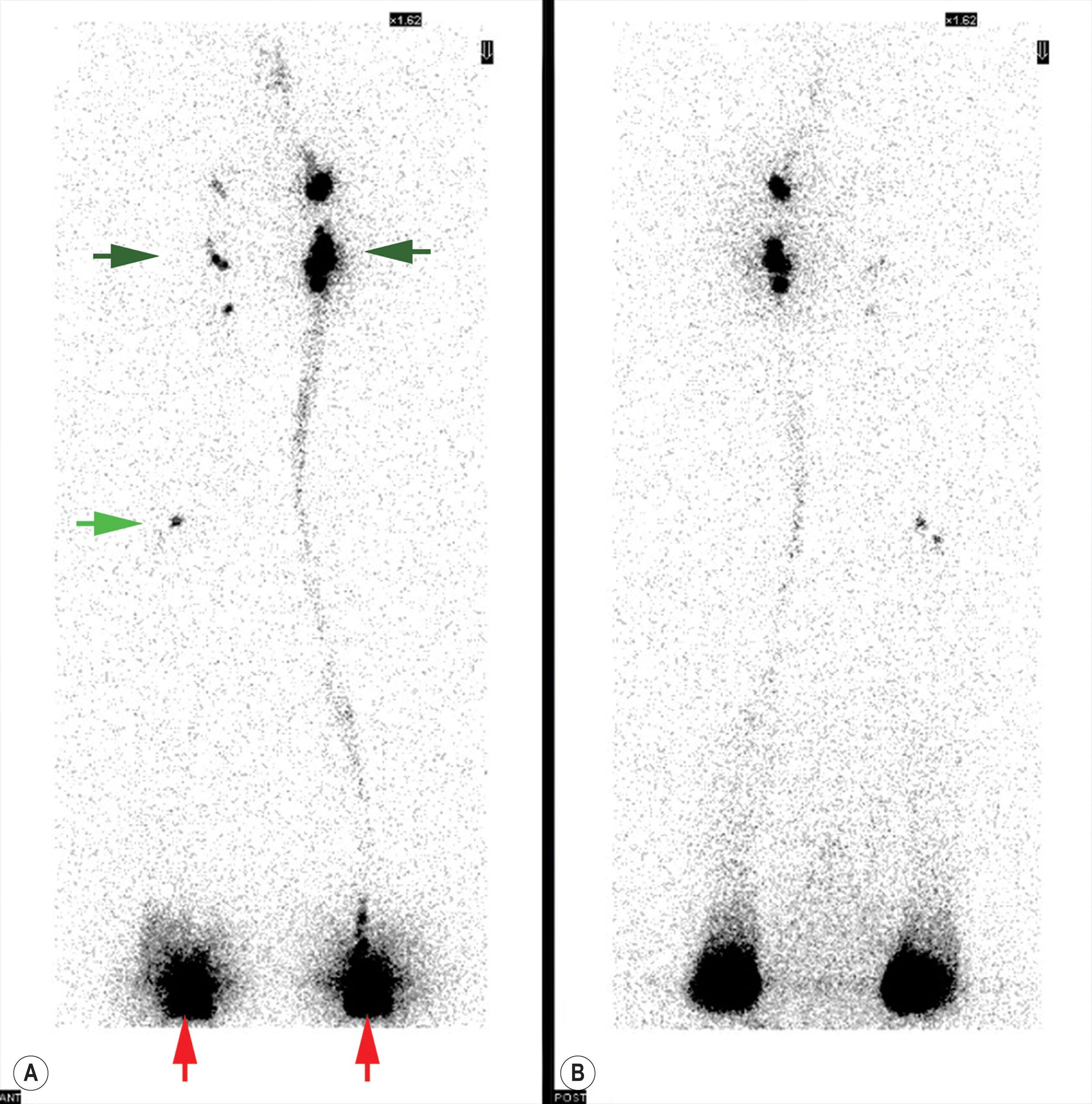
Quantitative or semiquantitative LS interpretations can be made about lymphatic function: the lymphatic transport index (TI) is calculated considering the parameters observed on LS images. TI values range between 0 (optimal) and 45 (compromised lymph flow). The lymphatic clearance (LC) can quantify lymphatic insufficiency, which can be obtained by measuring the reduction rate of radioactivity levels on the injection site, taking into account the radioactive decay of the isotope itself. Similarly, the uptake rate (UR) of the radioactive tracer in proximal lymph nodes can be objectively measured after a specific time period ( Fig. 3.2.2 ). Comparing radioactivity levels in the proximal regions between the healthy and affected sides provides another numerical rate to define the severity of lymphedema.
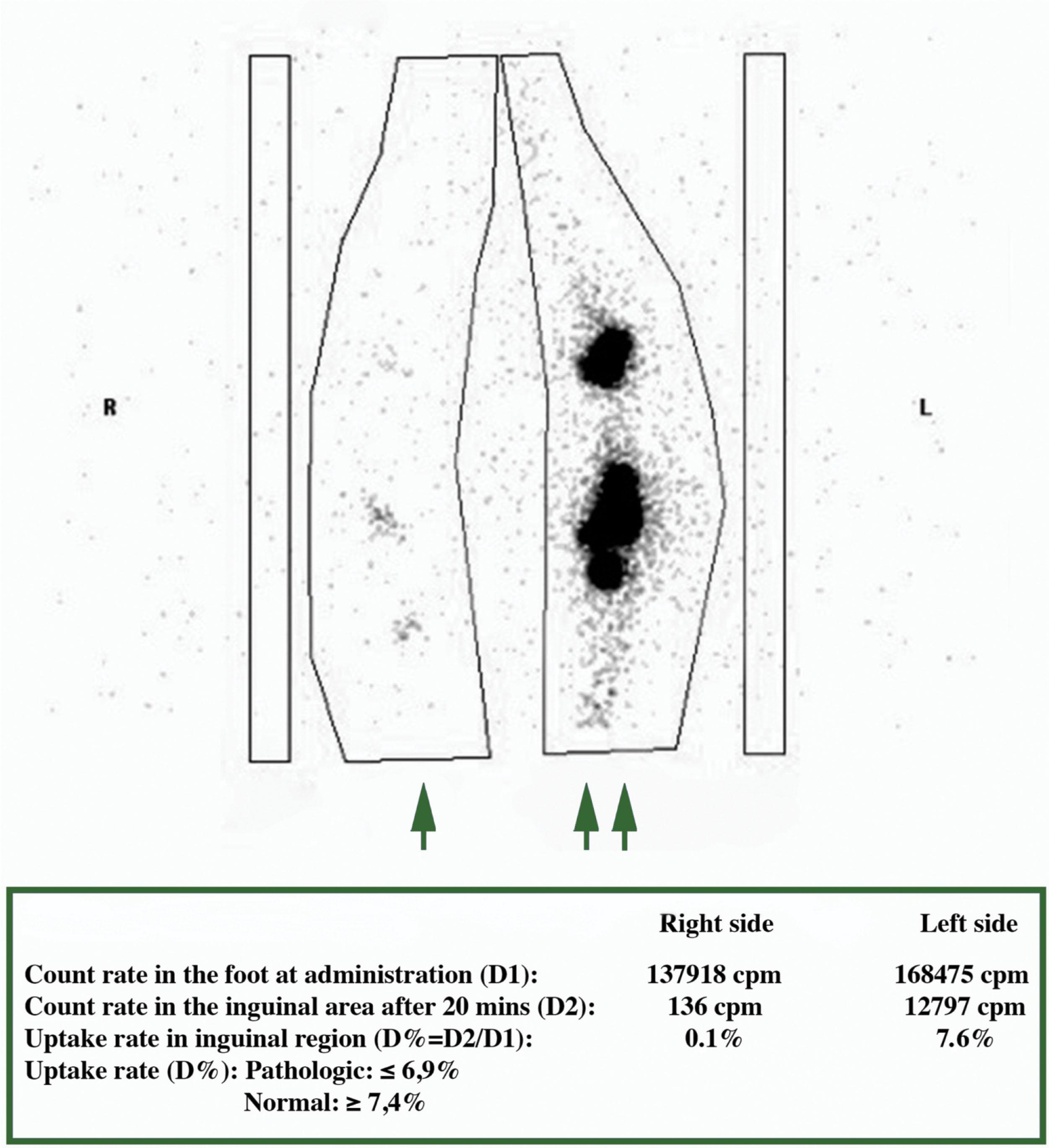
Qualitative LS evaluation and staging: for these assessments, isotope distribution is observed in lymph nodes and vessels on each side. A lymphatic obstruction causes abnormal lymph flow into the dermis, represented as dermal backflow on lymphoscintigraphic images. In specific primary lymphedema cases, LS not only confirms the diagnosis of lymphedema, but it is also feasible to deduce the etiology, such as lymphatic aplasia, hypoplasia, or hyperplasia.
For specific indications, LS can be used for planning lymphatic surgery. LS is obtained to reveal functional lymph nodes by detecting the location of isotope accumulation. Functional lymph nodes can indicate either the optimal lymph vessels for efferent lymph vessel anastomosis (ELVA) or lymph node–venous anastomosis (LNVA). It is advisable to assess the lymphatic function (and disclose the presence of lymph nodes) in the donor site of the vascularized lymph node transfer (VLNT), particularly in patients with primary lymphedema. Radioactive tracers are used for reverse lymphatic mapping in patients with lymph node transplantation to avoid donor site morbidity. Proximal accumulation of the isotope in the lymphedematous limb indicates some degree of remaining function, which should be preserved with careful, meticulous preparation during scar release or preparing the recipient site for lymphatic tissue transfer.
Although LS has gained many applications, it has drawbacks. According to some recent publications, its sensitivity and accuracy in diagnosis and staging are questionable. Patients are exposed to ionizing radiation: 99m Tc has a short half-life (6 hours), but as long as it is not excreted entirely, radioactivity can damage cells. Producing and processing isotopes are expensive, as is the LS equipment, which is large and heavy. Compared to current technologies, LS images are poorly defined (spatial resolution: ~1.5 cm) and may not give sufficient information on the lymph vessels and nodes. Other emerging imaging modalities may gradually be replacing LS in some indications.
Near-infrared fluorescent (NIRF) imaging or ICG lymphography in lymphatic imaging is the mainstay diagnostic tool in many centers and has found widespread application. There is no radiation exposure involved, and it can be performed in the clinic. It is a practical and cost-efficient method that provides a baseline evaluation.
Indocyanine green (ICG), a fluorescent dye, was developed to measure cardiac output (not influenced by changes in blood oxygen saturation) and has been used to investigate liver function and visualize vascular anomalies in the brain or the choroid plexus in the eye. It is approved in an aqueous solution for intravenous administration only. For lymphography, it has to be introduced intradermally as an off-label use. Pharmacokinetically, it binds preferentially to HDL and LDL lipoproteins. Bonded ICG molecules undergo a selective lymphatic uptake, and they emit near-infrared (NIR) light upon excitation by a laser light source. A NIR camera is used for visualizing the real-time lymph flow. It detects the initial lymphatic network and lymph vessels only up to a limited depth (1–2 cm). Resolution (typically in μm) depends on the depth and device.
ICG can be injected into multiple sites in or around the lymphedema areas, commonly into the second and fourth interdigital spaces of the extremities. A fill-and-flush drainage technique or active movement is used to promote lymph flow. The early distribution of ICG is observed right after the injection. The late plateau phase can be evaluated between 2 and 18 hours later, depending on lymphatic transport and centers. Functional lymph vessels are represented as linear patterns ( Fig. 3.2.3 ). Areas of disrupted lymph drainage are depicted as dermal backflow patterns, which are further classified. They are shown as reticular patterns in the early phase and turn into splash (dilated lymphatics), stardust (lymph extravasation), and diffuse (profuse extravasated lymph) patterns at the late phase ( Figs. 3.2.4, 3.2.5 ). It is possible to expose a few superficial veins, as dark shades crossing over lymph vessels or dermal backflow patterns – enhanced visualization of veins after subdermal administration of ICG ( Fig. 3.2.6 ). The size and the blood flow of the vein cannot be measured.
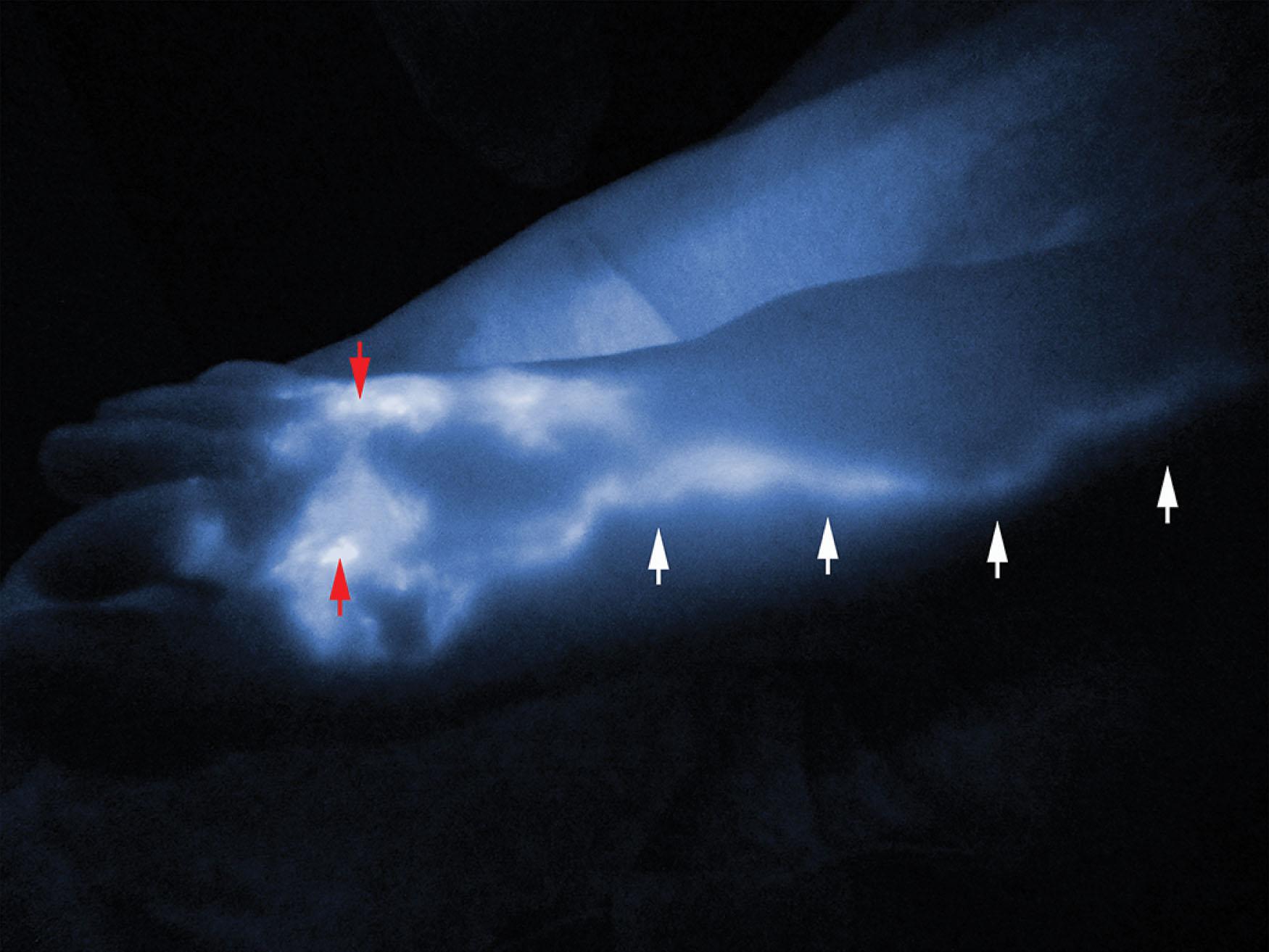
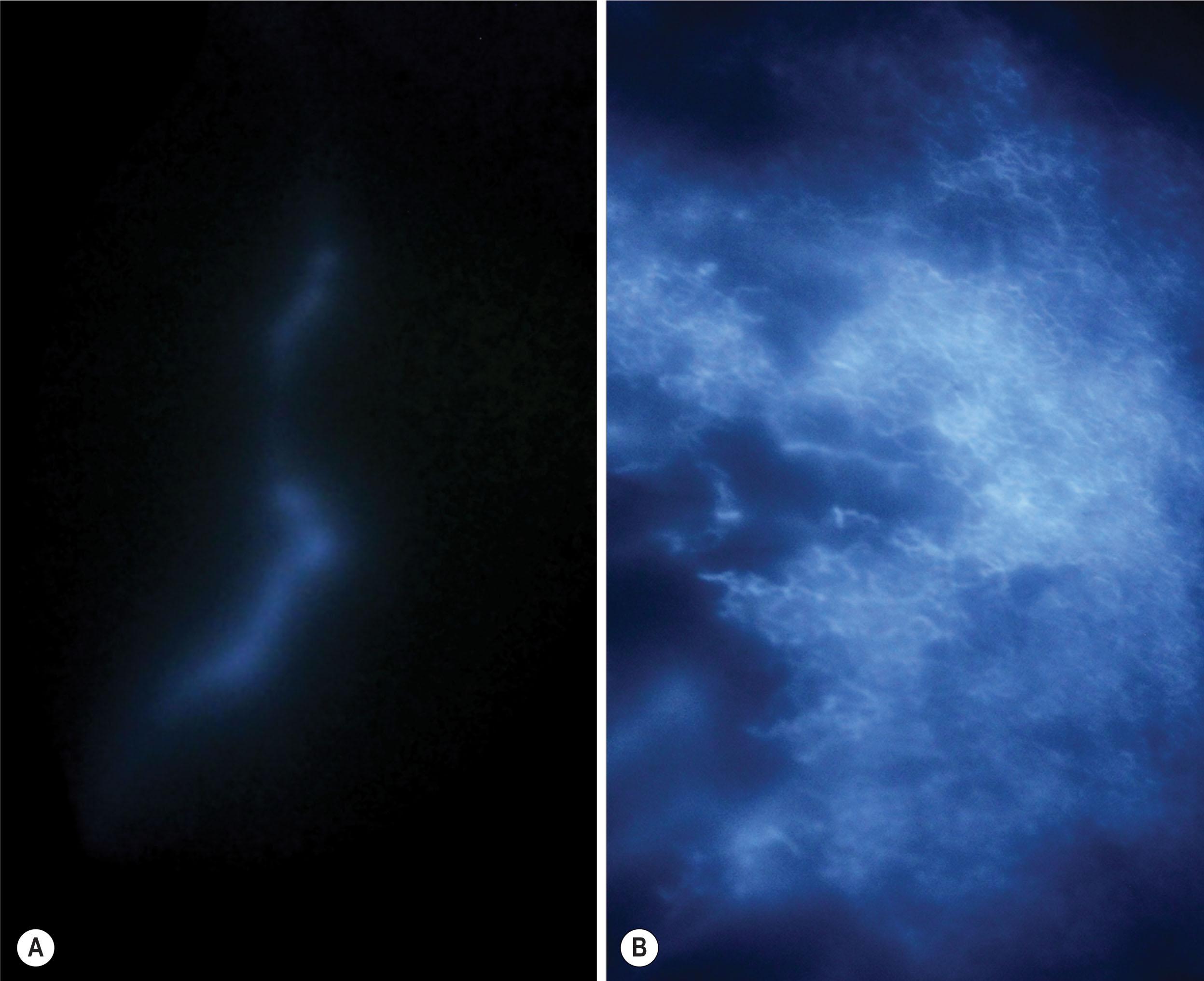
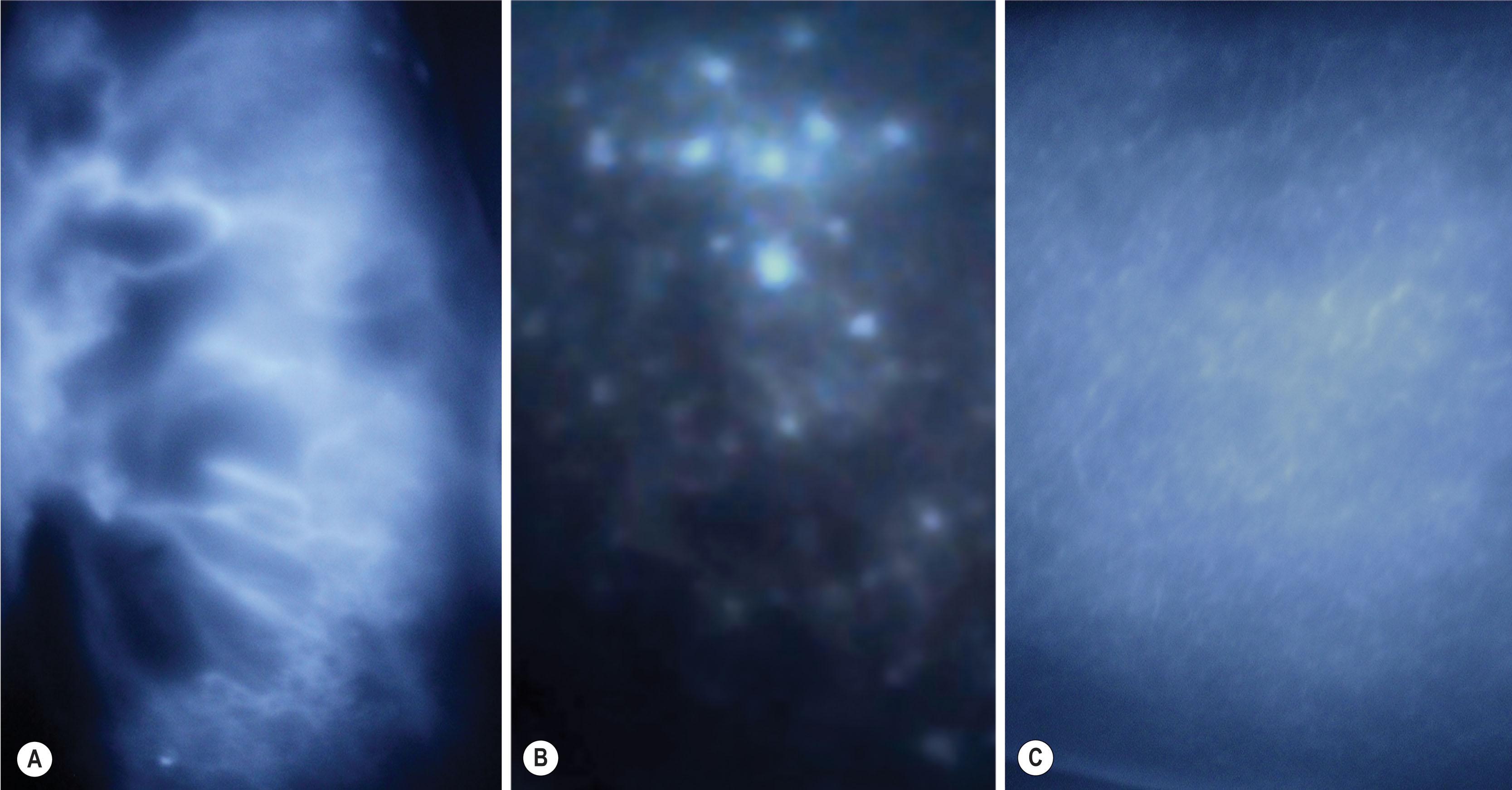
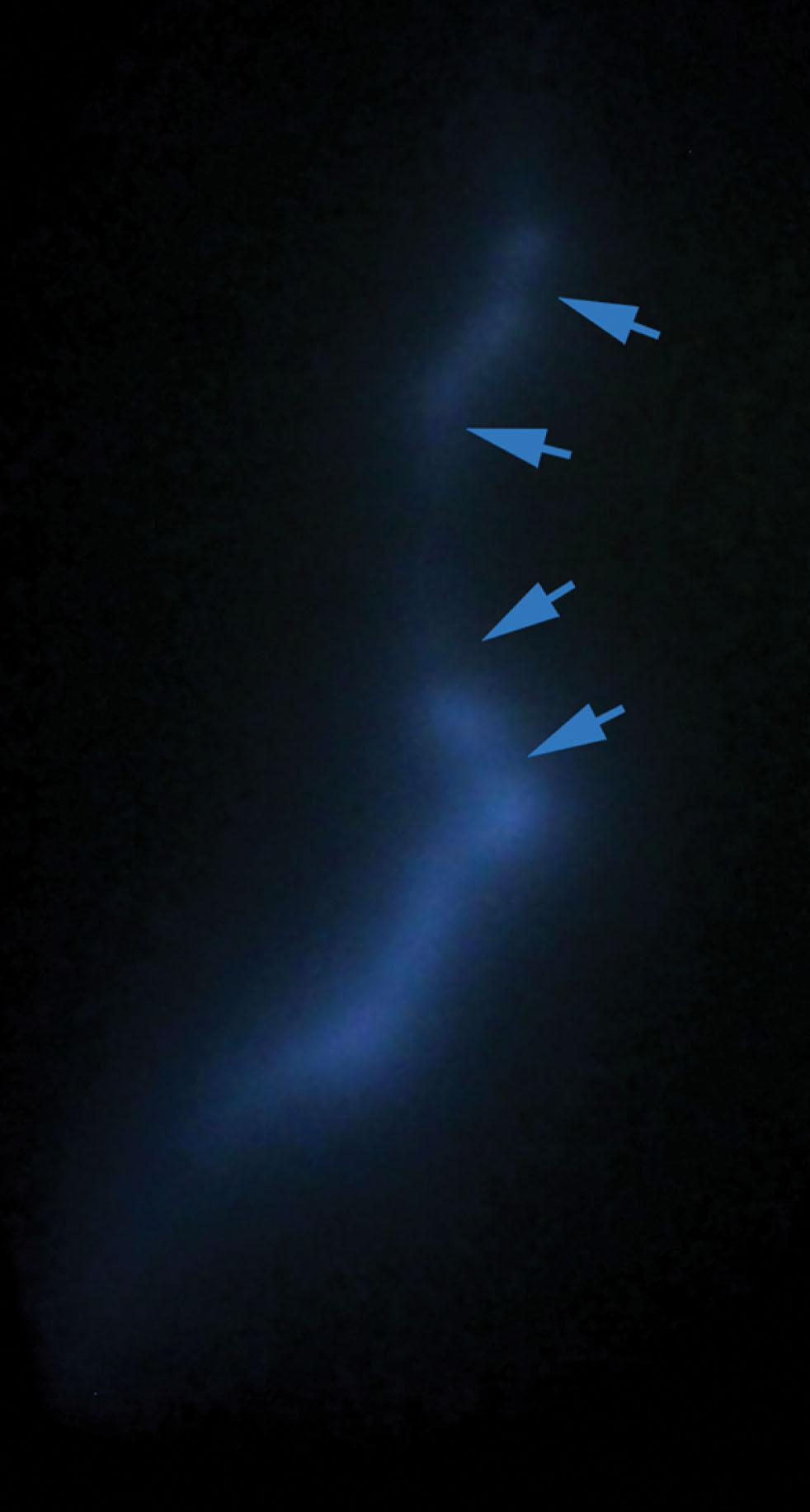
ICG lymphography has become the gold-standard for diagnosing lymphedema in some institutions. Its sensitivity reveals compromised lymph flow even at early stages, enabling timely treatment and improved outcomes after physiologic reconstructive procedures. ICG staging utilizes the dermal backflow patterns to describe the pathophysiologic changes. Because these interpretations are qualitative, they cannot be standardized. It has been reported that the Lymphedema Life Impact Scale (LLIS) does not correlate well with the ICG staging system; therefore, levels of disability caused by lymphedema cannot be predicted based on the ICG staging. Quantitative evaluation of lymphatic function is also feasible by assigning transit times of ICG dye, and contractility of lymph vessels.
ICG lymphography yields valuable information in the planning of lymphatic surgeries. Linear patterns indicating candidate lymph vessels for LVA surgeries are revealed in the early phase after injection ( ![]() ). These patterns are frequently outshone by dermal backflow patterns in the late phase. Our approach is to favorably position LVA sites at the border of linear and dermal backflow patterns, or on the overlapping regions of early ICG and late dermal backflow patterns ( Fig. 3.2.7 ). Congestion is usually suspected proximal to the linear pattern. We recommend preserving lymph vessels showing flow into the axilla or inguinal lymph nodes and not using them for LVAs. For efficient LVA surgery planning, it is advisable to use ICG in complement with other imaging methods.
). These patterns are frequently outshone by dermal backflow patterns in the late phase. Our approach is to favorably position LVA sites at the border of linear and dermal backflow patterns, or on the overlapping regions of early ICG and late dermal backflow patterns ( Fig. 3.2.7 ). Congestion is usually suspected proximal to the linear pattern. We recommend preserving lymph vessels showing flow into the axilla or inguinal lymph nodes and not using them for LVAs. For efficient LVA surgery planning, it is advisable to use ICG in complement with other imaging methods.
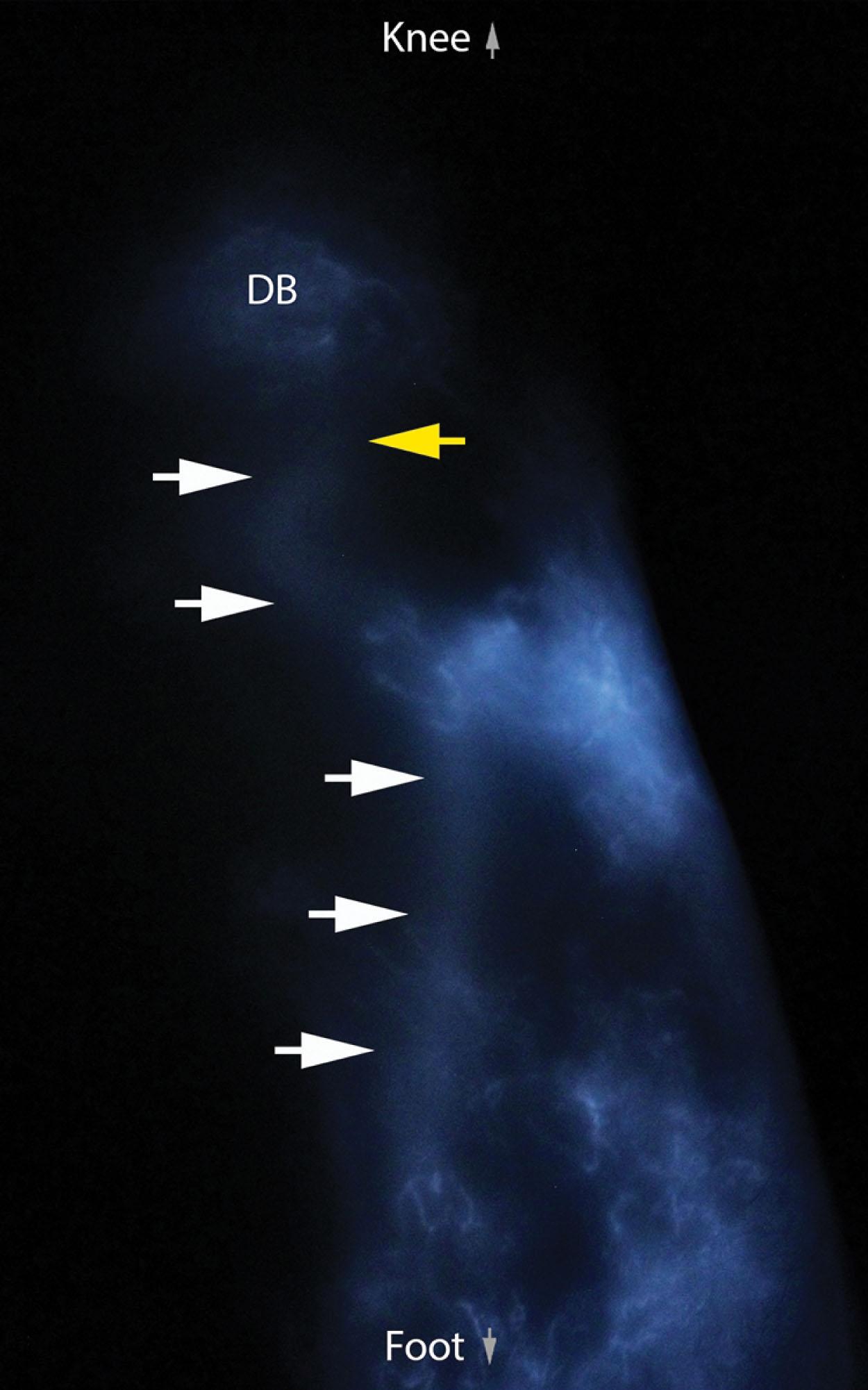
Intra-operative ICG imaging can be carried out through microscope-integrated NIRF imaging. It accelerates dissection of lymph vessels containing ICG and ensures the patency of the anastomosis ( Fig. 3.2.8 and ![]() ). Intra-operative ICG angiography can support free vascularized lymphatic tissue transplantation by providing information on flap perfusion. ICG lymphography is suitable for postoperative follow-up as well; lymphatic remodeling or the patency of LVAs might be investigated.
). Intra-operative ICG angiography can support free vascularized lymphatic tissue transplantation by providing information on flap perfusion. ICG lymphography is suitable for postoperative follow-up as well; lymphatic remodeling or the patency of LVAs might be investigated.
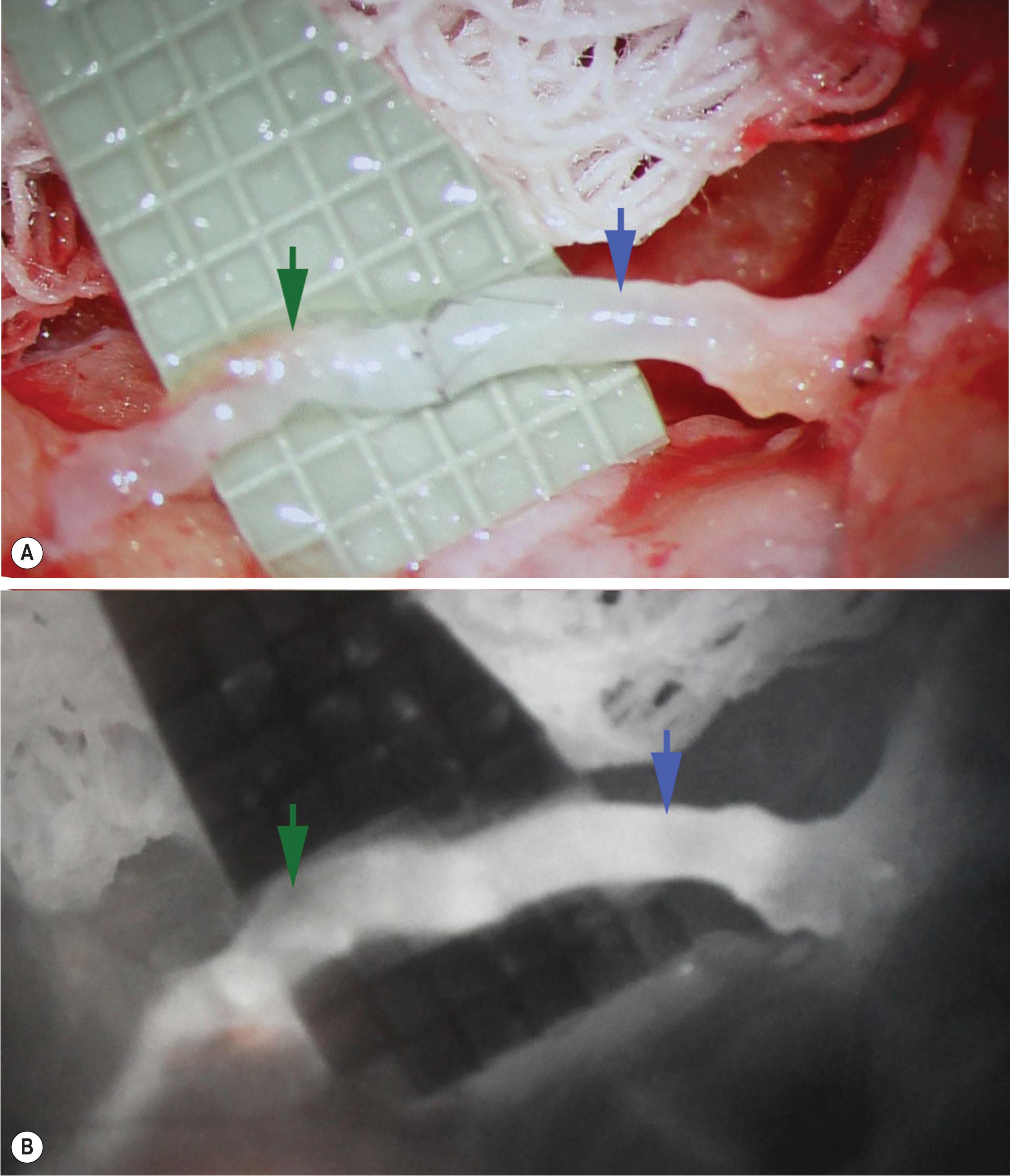
ICG lymphography has various drawbacks. First of all, the limited imaging depth mainly reveals superficial lymph collectors only. The commercially available ICG probes contain sodium iodide, as they should not be used in patients with thyroid tumors or hyperactivity. Cautious use is required in dialysis patients and ones with iodide intolerance. (However, there is no scientific evidence of the existence of allergic reaction – especially anaphylaxis – against iodine.) As a consequence of being a contrast-based method, ICG lymphography cannot detect lymph vessels not connected to the injection site. With its self-quenching, low quantum-yield, and poor stability, the physical attributes of ICG are suboptimal. An improved dye would further enhance the significance of NIRF imaging in lymphedema applications.
Become a Clinical Tree membership for Full access and enjoy Unlimited articles
If you are a member. Log in here